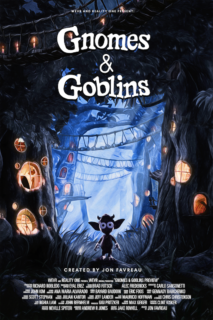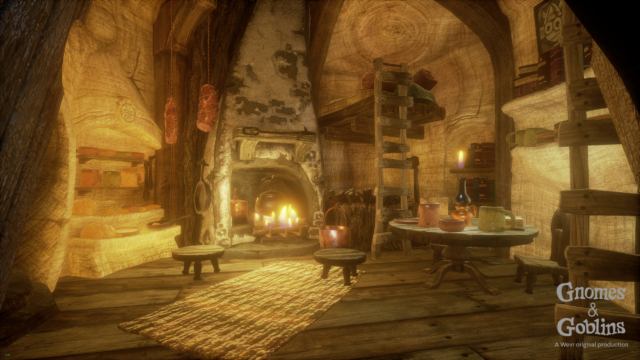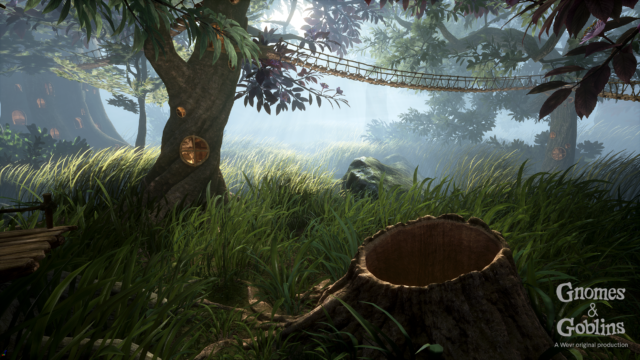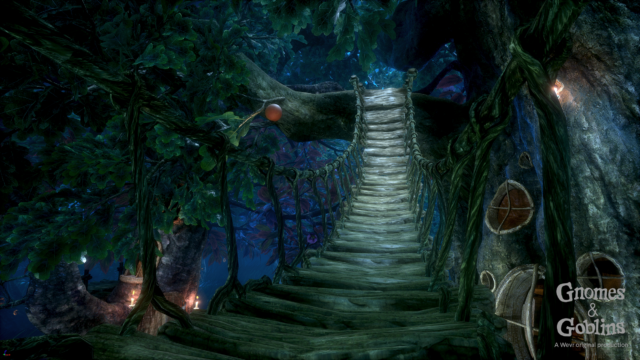Gnomes & Goblins is a virtual reality original production that infuses an explorative experience with room-scale technology to immerse users in an enchanted fantasy world shaped from the imagination of Jon Favreau, the actor and filmmaker of Iron Man, The Jungle Book and Swingers fame.

In the native experience created by VR content studio Wevr—which is neither a game nor film—users will meet and develop a personal relationship with an enigmatic character of Favreau’s interactive fantasy and begin discovering its many realms and denizens in a magical world.
“This project was one where I felt like there had to be a lot of room for exploration,” said Favreau. “It wasn’t one where I wanted to know where we were going when we started. And so I wanted to work with a smaller company that had more of a lab feel rather than feeling like I was creating content for an established goal. You’re only as good as the people you are collaborating with and the whole team, although small, is a group of people that share a singular vision and a commitment to breaking new ground and trying to discover things. The appeal is to have somebody who is not a gamer and never had a VR experience, be able to enjoy without feeling that they need to have a certain skill set, but we also don’t want it to be passive cinematic experience where people just sit and enjoy it like a ride. It needs to be something where you engage in the way that you would in life. It should feel like you’re developing a relationship with these characters.”
Favreau said that presence was the most interesting phenomenon when he experienced VR for the first time. He called it “lucid dreaming” because people know what they’ll be seeing is artificial, yet, their brain fools them into believing it’s real. Favreau said he referred to the Turing Test to see if an entirely artificial environment can make people feel a sense of human connection. Gnomes & Goblins effectively presents a new entertainment paradigm.
Although it was the 49-year-old Favreau’s first foray into VR, he was not the guy behind the guy as he once was back in the day in Swingers. But he did work with a team of VR pros for the project, co-produced and co-published by Wevr, who earlier this year procured $25 million to become the YouTube of VR.
Neville Spiteri, co-founder and CEO of Wevr, who previous to that served as producer and senior development director at Electronic Arts, joined [a]listdaily to further detail how Favreau and company brought Gnomes & Goblins to life.
Why was the collaboration with Jon Favreau a good fit for the Wevr company profile? How did the project start?

Wevr is a VR studio creating high-quality experiences that are native to the VR medium. We’re exploring and pioneering interactive storytelling in VR. It was clear from the beginning that Jon’s storytelling sensibilities and curiosity to explore the VR medium couldn’t be a better fit for Wevr. Wevr animation director Andy Jones was working on the film The Jungle Book with Jon, and he brought him to Wevr’s office to check out our newest VR piece, theBlu: Whale Encounter. Jon was quite taken by theBlu and how it offered that sense of immersion and scale when coming face to face with the whale, and began thinking of how he could create characters and worlds and tell stories in VR. We started talking about his visions and quickly rolled into developing ideas. I brought on Jake Rowell, director of theBlu, as creative director for the project, and working with Jon and Jake and Andy Jones and the team . . . and Gnomes & Goblins came to life.
How do you explain what the immersive experience really is like?
Gnomes & Goblins is neither a film nor a game—it’s an interactive VR experience, and the outcome hinges on how the user interacts with the characters and environment. The user isn’t simply a passive onlooker but rather an active participant that plays a role in how the experience progresses. Jon describes it as ‘lucid dreaming.’ Players are able to actually relate to the goblin character and see his emotions through his facial expressions and body language. The story is about you and the goblin. In this sense you’re an actor in the experience, and are central to the plot. Following Jon’s vision, we took the elements of agency from game design and married them with the narrative best-practices from filmmaking, and I think, together we’re onto something quite special with Gnomes & Goblins. It’s clear from the user feedback, that people are enjoying themselves and feeling the emotional connection.
Previews for Gnomes & Goblins are available on Steam and Viveport, and then, on Oculus Rift and PlayStation VR later in the year. How are you currently connecting with consumers? And what is their reaction after experiencing it?
We’re getting great consumer feedback. The positive reviews have been fantastic. From YouTube gaming influencers to users commenting on reddit and the reviews on Steam, it’s clear that the public is excited about Gnomes & Goblins. We constantly show the product and carefully watch people’s emotional reactions moment to moment. Our goal was to release a preview as a first ‘tasting spoon’ to engage the community early on in our development, to listen, get feedback, learn from it, and shape the experience based on that.

Why did you specifically go for room-scale VR?
Room-scale allows you to move around a space and interact with your surroundings and use your hands to pick up and touch items in the VR world, which leads to a stronger sense of immersion and presence. It was clear to Jon from the get-go that in order to give you that sense of immersion and connection with the characters and the world you need to be able to move around and explore, and literally approach the characters and see how they respond. Jake designed a space in which you’re invited to explore and interact in order to achieve the sense of immersion and presence that makes this experience feel like you’re really transported to a fantasy world. You can really deliver that feeling with room-scale.
How big is your vision for Gnomes & Goblins? What do you want for it to become?
Jon has a big wonderful vision for the full world of Gnomes & Goblins. We’re now gathering feedback and engaging the community. We have the underpinnings in place to introduce more characters, expand the goblin world and the gnome world, add more plot lines and activities for the user to engage in. It will evolve more like a game with expanded versions, and the goal is for this to become a persistent universe that grows over time. Wevr has partnered with RealityOne to coproduce the full version of the experience. Jon and the whole team is excited to be building out what’s next.

How important is it to have a Hollywood filmmaker’s mind like Jon involved for VR projects to have critical acclaim? What are some things he saw from a storytelling standpoint that other creators normally don’t?
It’s very important. In this case, Jon’s incredible talent and curiosity pushes the project and the medium forward. What’s really interesting about collaborating with Jon is that despite his established expertise as a moviemaker, he quickly saw what’s different about VR as a real-time interactive medium and was willing to experiment and take a fresh approach and mind-set to shape ‘how the story is told’ in VR.
What is the most difficult part about being a VR startup? How are you measuring success of previous projects?
One of the biggest challenges of being a VR startup is that even though VR is ‘hot’ and will undoubtedly grow into a massive market, it’s still in the early days. So you have to pick and choose carefully where you invest energy in terms of time and money. At Wevr we’re deeply passionate about the medium and are fanatical about crafting experiences that people absolutely love. We’re measuring our success by the caliber of work we put out, and by how the rapidly growing VR community responds.

How would you describe the current consumer appetite for VR content? What kind of an experience works best for the platform?
Consumers are hungry for VR content—a wide variety of content categories. I would say easily that more people want to consume VR content today than actually own a VR headset. There’s passive 360-degree video, cinematic experiences like theBlu, and fully interactive games—across many genres like music, drama, comedy, horror and sci-fi. We developed a meditation simulation with [author] Deepak Chopra where the user is intentionally invited to be still and calm which works really well in VR. We collaborated with [animator] Tyler Hurd who created “Old Friend,” an interactive music video in which you can’t help yourself from dancing, and that worked really well. The 10-episode drama narrative series Gone that we developed with Skybound and Samsung is a totally different format and that works great, too. Turns out VR is pretty powerful for all kinds of experiences. I personally find that experiences that provide some degree of agency while also incorporating story can really shine in VR. Gnomes & Goblins is an example of this.

What is currently the biggest challenge for marketing VR?
You can’t explain VR to someone who hasn’t experienced it. Not really. The biggest challenge in marketing VR today is describing the medium to the uninitiated—people really need to try it for themselves to truly get it. As VR continues to get press, and developers and studios release innovative and entertaining pieces that become more widely available, more people will get to experience VR for themselves which is what it’s all about. Accessibility is key. This is why we’re developing the Wevr Transport network to showcase VR content and market it in-and-outside of a headset, and provide a unified distribution network for mobile devices, in-home PCs/consoles, and to venues and experience centers throughout cities around the world. We’re addressing the challenge by enabling people who don’t have a VR headset to experience VR.
What’s next for Wevr plan on continuing to expand capability in the space?
On the network side of the business we launched the Transport VR network to showcase premium quality VR content. Transport is in public beta on GearVR and Vive, and next up is Daydream and Oculus Rift. It’s really working. We’re now extending Wevr Transport to distribute content to venues in neighborhoods and cities around the world. It’s all about making great VR and taking it to the people. On the studio side of the business we had four titles accepted at Sundance this year and have 11 nominations at the upcoming Proto Awards. We want to continue to experiment, and learn, and push for high-quality experiences and collaborate with the greatest storytellers of our time to make killer VR content. In addition to creating more Wevr originals, we’re actively investing in the growing community of VR creatives.
Follow Manouk Akopyan on Twitter @Manouk_Akopyan

